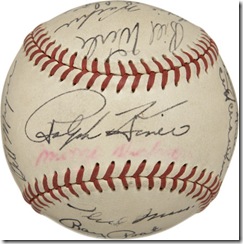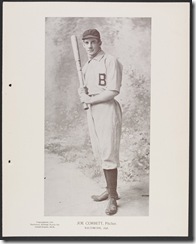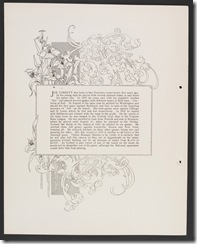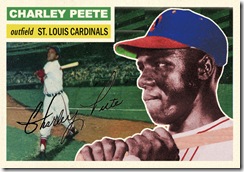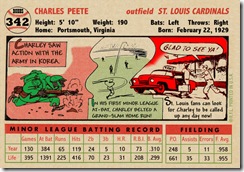What may well be the sole surviving complete set of 1898-99 National Copper Plate Company player pictures has been consigned to, and will undoubtedly prove to be the featured lot in, the premiere Collect.Com sports card and memorabilia auction on June 18.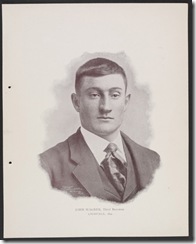
The NCP Portraits, as they are not entirely correctly listed (as will be seen later) in the Standard Catalog of Baseball Cards, were produced by that company at the end of the 19th Century in Grand Rapids, in southwestern Michigan. At that time the city was home to the Western Association Grand Rapids Rustlers, the team that would eventually become the Cleveland Indians with the formation of the American League 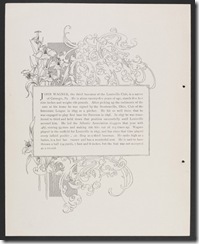 in 1901.
in 1901.
National Copper Plate Co. appears to have been a specialty engraver producing illustrative plates for periodical and book publishers in an era when photo illustrations in the print media were uncommon.
With the opening of the 1898 baseball season, NCP began offering what it advertised as its “Art Gallery of Prominent Base Ball Players of America.” The pictures were initially issued in series of about six each and sold for 10 cents per series.
The National Copper Plate pictures were issued in two sizes. Each were black-and-white photomechanical prints on semi-gloss paper. It appears that the pictures that were sold in series directly from the maker were about 9-1/2” x 12-1/2” in size. The version that has been consigned to the Collect.Com auction is in a size of 8-3/4” x 11.” Whether there are any significant differences in the images to be found on the differing sizes is largely a matter of conjecture because so few of the large-size prints are known. At least one player’s pictures differ in the two presentations, however. The vignetted portrait of Kid Nichols in the larger size is bordered all around with a double-line box; that box is absent on the smaller portrait piece.
The smaller 8-3/4” x 11” size was carried forward when The Sporting News contracted with National Copper Plate Co. to supply the sporting weekly with a series of baseball player pictures to be used as premium inserts. These inserts were given the American Card Catalog identification number of M101-1 and are distinguishable from the slightly earlier NCP pictures in that the TSN premiums have a printed line at top identifying them as “Supplement to The Sporting News, St. Louis, Mo.,” with an issue date between April 22-Dec. 9, 1899, and April 14-Oct. 20, 1900. The M101-1 pictures include 62 different players, compared to the 50-player checklist of the National Copper Plate set, though not all of the NCP players were re-issued as M101-1 pictures.
Besides providing The Sporting News with the weekly supplements, National Copper Plate also provided the “original” 50 NCP player pictures in a string-bound portfolio that was offered by TSN for $2 (including a one-year subscription to the sports weekly!).
Inasmuch as it is spelled out thereon, the original cover with which this set was discovered makes it clear that this is the portfolio that was offered as a subscription premium. It is not currently known whether this collection was available in any other manner. For the vast majority of collectors who have never seen it, the cover of the NCP portfolio is a curiosity in itself. It appears to be a heavily shellacked burlap, imprinted in black. On front is a rampant lion between lines of type that read: “VOL. 1. / Portfolio of / Prominent Ball Players” and “ISSUED BY / The Sporting News, / ST. LOUIS, MO.” The back cover pictures a catcher’s mitt and a fielder’s glove and is imprinted with advertising that reads, “The Ball Players Whose Pictures are in this Volume Use Reach Mitts and Gloves.” It carries the imprint of the A.J. Reach Co., Philadelphia.”
It can be reasonably assumed that the universe of the bound portfolios was a subset of the number of subscribers to TSN, specifically, those subscribers who chose to sign up or renew their subscription during the promotional period in which the offer was made.
The number of individual M101-1 portraits originally issued would therefore be greater than that of the NCPs, reflecting the nature of the TSN-branded version as inserts that were mailed with each subscriber’s copy of the paper, but were also given away with each copy of TSN sold on the newsstand, at the ballparks and other venues.
Theoretically, of course, the number of complete sets of the NCP portfolio portraits that have survived these 110 years would be greater because they were distributed only as bound sets. As rare as this surviving NCP set is (it may well be unique), it is unlikely that a complete set of the M101-1 versions even exists today, given the nearly 25% larger number of pieces comprising the issue and the fact that they would have had to have somehow remained together over the ensuing century, having been originally collected at a rate of a piece at a time, one-per-week.
While the Standard Catalog of Baseball Cards identifies this set as “1898-99 National Copper Plate Co. Portraits,” that is not entirely accurate. While it is true that the majority of the pictures have on their fronts a head-and-shoulders portrait of a National League player, either in street clothes or in uniform, five of the pictures have full-length portrayals of uniformed players. Not coincidentally, all of the full-length pictures in the portfolio are players from the Baltimore Orioles of 1898 or players who had been O’s in 1897 and were Washington Senators in 1898. At least one of the Baltimore player pictures carries a photo credit to Betz Photo Studio in that city.
The dual dates with which the set is identified reflects the fact that many of the pictures carry either an 1898 or an 1899 date along with the player name, position and team on front.
That period of issue gives the National Copper Plate and companion M101-1 pictures a near monopoly on the baseball player memorabilia market for that era. The pictures were issued in the “cardless” gap between the 1895 Mayo’s and the 1903 E107 caramel cards. The only significant contemporary baseball player collectible series was the 1898 Cameo Pepsin Gum pins, where many of the players from the NCP set also appear.
Even in the absence of a consensus hobby definition, it would be a stretch to call the National Copper Plate pictures “rookie cards,” despite the fact that for more than half of the players on the checklist, this appearance is their first, if not their only, appearance on a collectible. Thus, a collector seeking to assemble, for example, the earliest memorabilia depiction of each Hall of Famer would be a candidate to acquire the National Copper Plate Co. pictures of Jimmy Collins, Elmer Flick, Willie Keeler, Bobby Wallace, Vic Willis and, most significantly, Honus Wagner. The impressive size of these pictures places them outside of most collectors’ definition of a “baseball card,” although their format is prototypical of what we know today as baseball cards – that is, a photo and identification on front and a career summary on back.
In fact, the National Copper Plate pictures are the first significant baseball collectibles to have anything except advertising on their backs. And what backs they are!
Contained within a box at center is a career summary of the player. The write-up summarizes the player’s amateur and pro career and often includes such personal data as hometown, physical description, career highlights, off-season particulars and even, for some players, sordid details of on-going salary disputes. Given the quantity and quality of player information in those biographies it is possible that they originated with the data maintained in the editorial files of The Sporting News, another point of synergy between the two companies.
As mentioned, examination of the pictures in the NCP/TSN portfolio reveals that the introductory paragraphs for the set(s) in the Standard Catalog of Baseball Cards will need some revision. There will also be some changes made to the checklist for the set in that book, all related to discrepancies between how the player is identified on the picture itself and the form in which his name appears in the checklist.
For the first time anywhere we’ll present here a corrected checklist for the 1898-99 NCP pictures that includes the team with whom the player is pictured (always of particular interest to single-team collector specialists). Parenthetical initials after a player name will indicate that player’s NCP picture is: (R) a “rookie” issue (his first solo appearance on a baseball collectible; (O) his only known collectible, (F) a full-length picture, and, (M) also included in the M101-1 set. A few other notes are also included.
1898-99 National Copper Plate Portfolio of Prominent Baseball Players
(1) M.F. Amole, Washington (O)(F). Doc Amole’s middle initial was actually “G.” He played only two seasons in the majors, 1897-98.
(2) A.C. Anson, Chicago. This is technically a post-career contemporary issue as Anson retired as Chicago’s player-manager after the 1897 season.
(3) Robert Becker, Philadelphia (O). Becker pitched in only six M.L. games, all with the Phillies in 1897-98, with a 0-2 record.
(4) Martin Bergen, Boston (R)(M).
(5) James J. Collins, Boston (R)(M).
(6) Joe Corbett, Baltimore (O)(F). The only known baseball collectible of boxing champion Gentleman Jim Corbett’s brother.
(7) Louis Criger, St. Louis (R)(M).
(8) Lave N. Cross, St. Louis (M).
(9) Montford Cross, Philadelphia (R).
(10) Eugene DeMontreville, Baltimore (R)(M).
(11) Charlie Dexter, Louisville (R).
(12) P.J. Donovan, Pittsburg (R)(M). All other Pirates have the city name spelled with the ‘h” on the end.
(13) Thomas Dowd, St. Louis (O). Surprising because played in the major leagues for 10 years between 1891-1901.
(14) John J. Doyle, Washington (F)(M).
(15) Hugh Duffy, Boston (M).
(16) Frank Dwyer, Cincinnati.
(17) Fred Ely, Pittsburgh (R).
(18) A.F. Esterquest, Cleveland (O). Though property of the Indians, Esterquest never played in the major leagues. The shortstop was farmed out to Youngstown early in 1898.
(19) Wm. Ewing, Cincinnati.
(20) Elmer Harrison Flick, Philadelphia (R)(M).
(21) Daniel Friend, Columbus (O). Friend is the only player in the NCP set to be identified with a minor league team. From 1895-98 he had pitched for Chicago, with a 32-29 record, including 18 wins in 1896.
(22) Geo. F. Gilpatrick, St. Louis (O). His name was correctly spelled “Gillpatrick.” His big league career comprised only seven games with the 1898 Brown Stockings, and an 0-2 record.
(23) J.M. Goar, Cincinnati (R).
(24) Mike Griffin, Brooklyn (M).
(25) Clark C. Griffith, Chicago (M).
(26) Wm. Hill, Cincinnati (R).
(27) Wm. E. Hoy, Louisville.
(28) James Hughes, Brooklyn (R)(M).
(29) William Joyce, New York.
(30) William Keeler, Brooklyn (R)(M). Most of Wee Willie’s cards and collectibles date from his later association with the N.Y. Highlanders.
(31) Joseph J. Kelley, Brooklyn (M). Because he was with the Superbas for only a short part (1899-1901) of his Hall of Fame career, collectibles specifying that team association are rare.
(32) William Kennedy, Brooklyn (M).
(33) William Lange, Chicago (R)(M).
(34) John J. McGraw, Baltimore (M).
(35) W.B. Mercer, Washington (R). Win Mercer’s initials were actually “G.B.”
(36) Charles A. Nichols, Boston (M).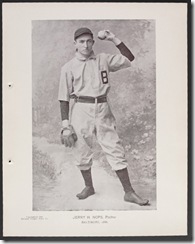
(37) Jerry Nops, Baltimore (F)(M). This is not technically an “only” card for Jerry Nops, as he does appear in the 1990 Target all-time Dodgers set, but it is his only career-contemporary issue, despite his having pitched in six major league seasons.
(38) John O’Connor, Cleveland (M).
(39) Richard Padden, Pittsburgh (R).
(40) Wilber Robinson, Baltimore (F)(M). Of course the Hall of Fame catcher’s first name was actually “Wilbert.”
(41) William Shindle, Brooklyn.
(42) Charles Stahl, Boston (R)(M).
(43) E.P. Stein, Brooklyn (O). Ed Stein’s middle initial was actually “F.” He falls into the only-collectible category despite having had an eight-year big league career with Chicago and Brooklyn, winning 109 games, including 27- and 26-win seasons with Brooklyn in 1892 and 1894 (he only 19 in 1893).
(44) S.L. Thompson, Philadelphia.
(45) John Wagner, Louisville (R)(M).
(46) R.J. Wallace, Cleveland (R)(M).
(47) Victor L. Willis, Boston (R)(M).
(48) Parke Wilson, New York (R).
(49) George Yeager, Boston (O). Because his career in the bigs was in the period 1896-1902, this is Yeager’s only known collectible. He played all over the diamond for Boston, Cleveland, Pittsburgh, the Giants and Baltimore.
(50) C.L. Zimmer, Cleveland.
Based on research done in conjunction with cataloging this extraordinary set, the introductory information presented for both this set and the related Sporting News M101-1 portrait premiums will be rewritten.
The (figurative) fall of the auctioneer’s hammer will determine how extensively the pricing columns for these sets will need to be rewritten.

 I was going through some boxes of misc. cards recently when I encountered some foil wrappers and redemption "Certificate Request Card" forms for a turn-of-the-century (seems funny to describe the late 1990s that way) Bowman promotion.
I was going through some boxes of misc. cards recently when I encountered some foil wrappers and redemption "Certificate Request Card" forms for a turn-of-the-century (seems funny to describe the late 1990s that way) Bowman promotion.



 The obscure multi-subject Topps Hocus Focus cards were issued nearly 55 years ago and we still don't have a complete checklist of the 23 players that make up the baseball subset. For many years the Standard Catalog checklist has reflected that cards #11, 17, 19, 22 and 23 are "Unknown."
The obscure multi-subject Topps Hocus Focus cards were issued nearly 55 years ago and we still don't have a complete checklist of the 23 players that make up the baseball subset. For many years the Standard Catalog checklist has reflected that cards #11, 17, 19, 22 and 23 are "Unknown."









